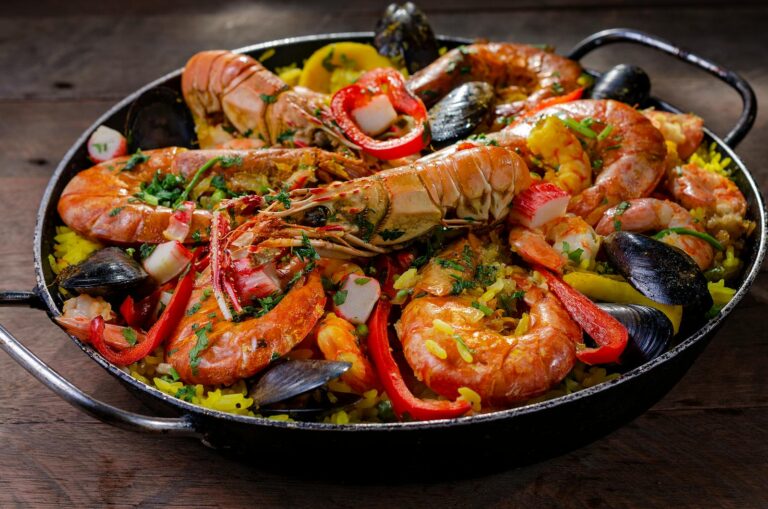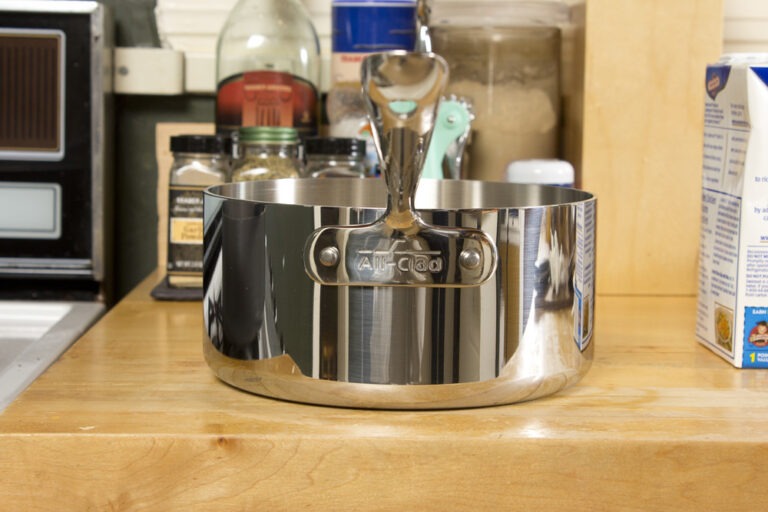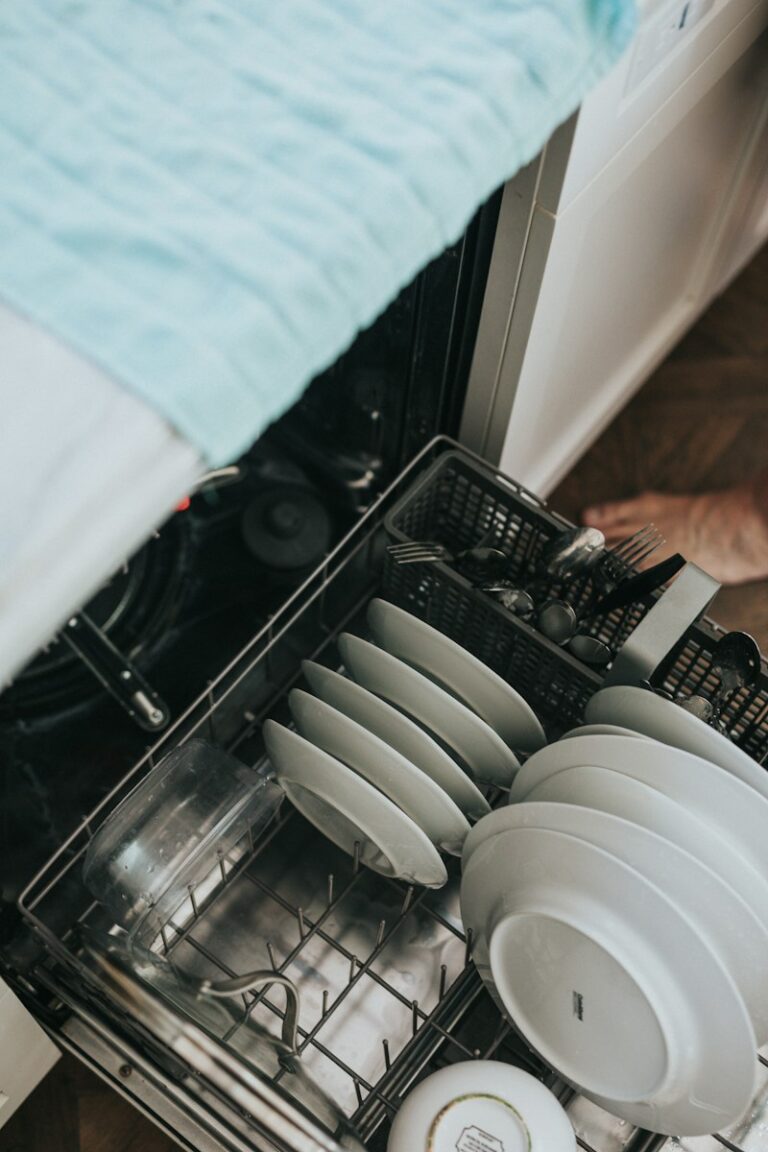Are you confused about which cooking pan material is best for your needs? Look no further!
In this article, we will compare different materials such as stainless steel, cast iron, non-stick, copper, aluminum, ceramic, and carbon steel.
Discover the pros and cons of each option, helping you make an informed decision.
Say goodbye to burnt food and hello to perfectly cooked meals with the right cooking pan material for you.
Key Takeaways
- Stainless steel and cast iron pans are durable, versatile, and provide even heat distribution and retention.
- Non-stick pans offer convenience but come with concerns about chemicals and limited lifespan.
- Copper pans have excellent heat conductivity but require regular maintenance and can react with acidic foods.
- Aluminum pans ensure effective and even heat distribution, durability, and longevity.
| Material | Durability | Non-Stick Properties | Heat Conductivity | Maintenance | Versatility | Approximate Cost Range |
|---|---|---|---|---|---|---|
| Stainless Steel | Highly durable and long-lasting | Limited non-stick properties | Even heat distribution | Easy cleaning, non-reactive, versatile | Suitable for all stovetops, oven-safe | Moderate to High |
| Cast Iron | Extremely durable, improves with time | Natural non-stick surface with seasoning | Excellent heat retention | Requires regular seasoning and maintenance | Suitable for stove-top, oven, grill | Low to Moderate |
| Non-Stick | Coating may degrade over time | Convenient non-stick cooking, but concerns | Even heat distribution | Gentle cleaning required, limited lifespan | Suitable for low-fat cooking | Low to Moderate |
| Copper | Requires regular maintenance | Limited non-stick properties | Excellent heat conductivity | May react with acidic foods, tarnishes | Suitable for various cooking methods | High |
| Aluminum | Durable and long-lasting | Limited non-stick properties | Even and efficient heat distribution | Requires careful handling to prevent damage | Suitable for various cooking methods | Low to Moderate |
| Ceramic | Moderate durability, may chip over time | Excellent non-stick properties | Even heat distribution | Easy cleaning, low maintenance | Suitable for various cooking methods | Moderate |
| Carbon Steel | Durable with proper seasoning | Natural non-stick surface with seasoning | Quick and even heat distribution | Requires seasoning to prevent rust | Ideal for high-heat cooking | Moderate |
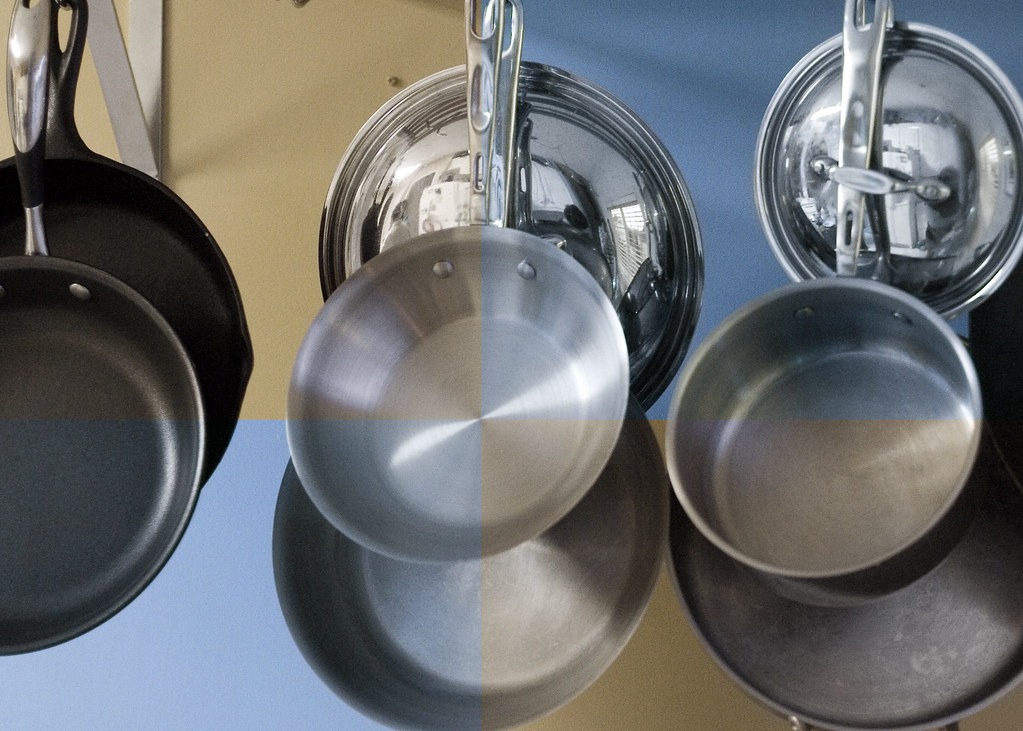
Stainless Steel
If you want a durable and non-reactive option, stainless steel is the material for you. Stainless steel pans have many advantages that make them a popular choice among home cooks and professional chefs alike.
Firstly, stainless steel is extremely durable, so you can expect your pans to last for a long time. They’re also non-reactive, meaning they won’t leach any harmful chemicals or flavors into your food.
Cleaning stainless steel pans is a breeze. To keep them looking their best, simply soak them in warm soapy water, scrub with a non-abrasive sponge, and dry thoroughly.
Another advantage of stainless steel pans is their versatility. They can be used on any type of stovetop and are oven-safe.

Cast Iron
Cast iron pans are known for their durability and ability to retain heat. They’ve been a staple in kitchens for generations, and for good reason. Here are some reasons why cast iron pans are a great addition to your cooking arsenal:
- Versatility: From searing steaks to baking cornbread, cast iron pans can do it all. They’re perfect for stove-top cooking, oven baking, and even outdoor grilling.
- Benefits of seasoning: Seasoning a cast iron pan creates a non-stick surface that improves with time. The more you use it, the better it gets. This means you can cook with less oil and enjoy healthier meals.
- Imagery: Picture yourself flipping a perfectly golden pancake on a sizzling hot cast iron pan. The steam rises, the edges crisp up, and the aroma fills the air. It’s breakfast perfection.
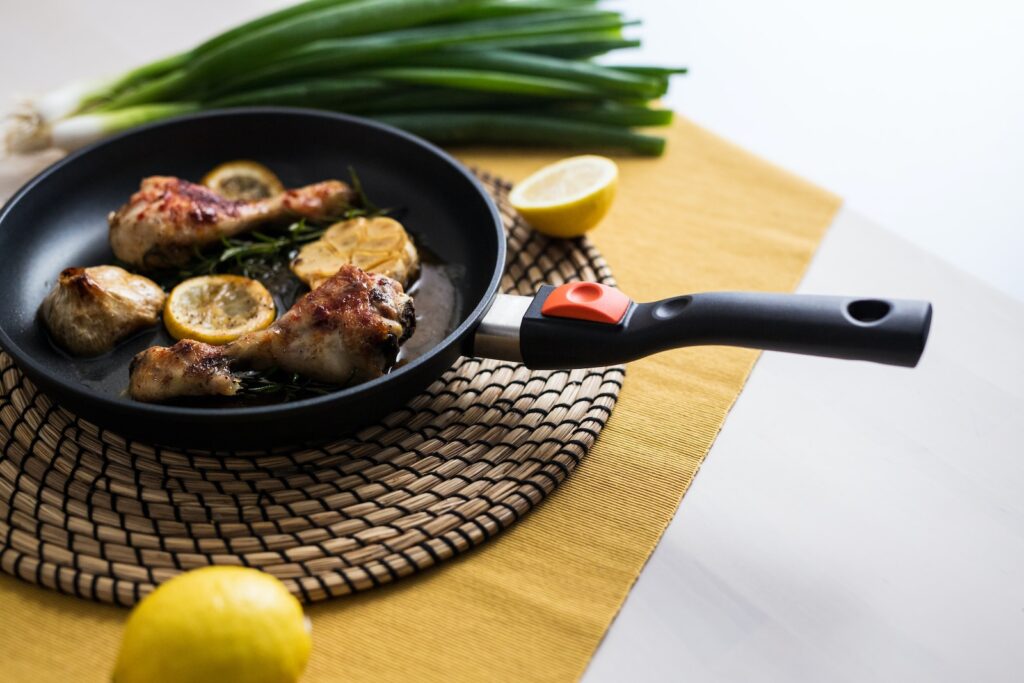
Non-Stick
If you’re looking for a convenient and easy cooking experience, non-stick pans might be your go-to choice. They’re designed to prevent food from sticking, making cooking and cleaning a breeze.
However, there are a few important things you should know about non-stick pans before using them in your kitchen.
Health Concerns With Non-Stick
You should be aware of potential health concerns with non-stick cookware. While convenient, non-stick pans can pose toxicity risks due to the chemicals used in their manufacturing process. Here are some things to consider:
- Chemical Release: Non-stick coatings can release harmful fumes when overheated, which may cause flu-like symptoms known as ‘Teflon flu.’
- Scratching Hazard: Scratches on the non-stick surface can lead to the release of toxic substances into your food.
- Limited Lifespan: Non-stick coatings deteriorate over time, requiring replacement and contributing to environmental waste.
Fortunately, there are alternative options to consider:
- Stainless Steel: Durable, versatile, and non-reactive, stainless steel pans are a safe and healthy choice.
- Cast Iron: With proper seasoning, cast iron pans provide a naturally non-stick surface and add iron to your diet.
- Ceramic: Ceramic-coated pans offer a non-toxic alternative, providing excellent non-stick properties without the use of chemicals.
Durability of Non-Stick
Non-stick coatings may start to degrade over time, potentially leading to a shorter lifespan for your non-stick cookware. It’s important to understand the durability of non-stick pans to make an informed decision about your kitchen essentials. While non-stick pans offer convenience and ease of use, they may not stand the test of time like other materials. To help you compare the durability of different cooking pan materials, here is a table showcasing their characteristics:
| Material | Durability |
|---|---|
| Non-stick | Coating may degrade over time |
| Stainless steel | Highly durable and long-lasting |
| Cast iron | Extremely durable, but requires maintenance |
| Ceramic | Moderate durability, may chip over time |
When considering the health benefits, non-stick pans are often preferred for their ability to cook with less oil or butter. However, it’s important to note the environmental impact of these coatings, as they can release harmful chemicals when heated at high temperatures. Consider your cooking needs, health concerns, and environmental impact when choosing the right cookware for your kitchen.
Cleaning Non-Stick Pans
To maintain the non-stick surface of your pans, it’s important to use gentle cleaning methods and avoid abrasive scrubbers or harsh chemicals. Here are some proper cleaning techniques to keep in mind:
- Use a soft sponge or cloth: Gently wipe away any food residue or grease using a soft sponge or cloth. Avoid using steel wool or abrasive scrubbers that can scratch the non-stick coating.
- Non-abrasive cleaners: Opt for mild dish soap or non-abrasive cleaners specifically designed for non-stick pans. Harsh chemicals can strip away the non-stick coating, reducing its effectiveness.
- Avoid high heat: Exposing your non-stick pans to high heat for long periods can damage the coating. Always cook on medium or low heat and never use metal utensils that can scratch the surface.

Copper
Copper pans conduct heat quickly and evenly, making them a popular choice among chefs. When it comes to cooking, copper offers several benefits. Firstly, its excellent heat conductivity allows for precise temperature control, ensuring your food cooks evenly. Additionally, copper pans heat up faster, reducing cooking time and saving energy.
Moreover, copper is a durable material that can withstand high temperatures, making it suitable for various cooking techniques, including frying and sautéing. However, there are a few drawbacks to consider. Copper pans require regular maintenance to keep them looking their best, as they can tarnish over time. Additionally, copper can react with certain acidic foods, resulting in a metallic taste. Despite these drawbacks, many chefs still prefer copper pans for their exceptional cooking performance.
| Benefits | Drawbacks |
|---|---|
| Excellent heat conductivity | Requires regular maintenance |
| Reduces cooking time | Can react with acidic foods |
| Durable material |
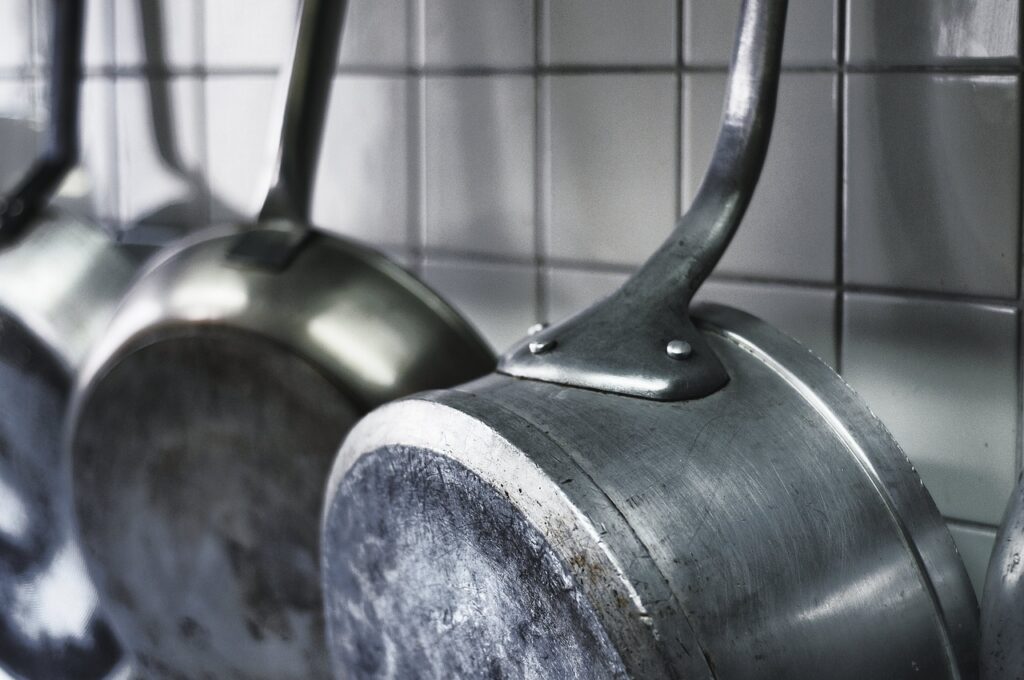
Aluminum
Aluminum is a popular choice for cooking pans because it distributes heat effectively and evenly. It’s also known for its durability and longevity, making it a reliable option for everyday cooking.
With aluminum pans, you can expect consistent and efficient heat distribution, ensuring that your food is cooked evenly every time.

Heat Distribution Effectiveness
If you use stainless steel pans, you may notice that heat distribution isn’t as effective as with copper or aluminum pans. The lack of conductivity in stainless steel affects its ability to evenly distribute heat. As a result, you might experience hot spots or uneven cooking.
Imagine placing a thick steak on the stainless steel pan, only to have one side searing while the other remains cool. It’s like trying to cook a pancake and ending up with one side burnt and the other side barely cooked.
Stainless steel pans struggle with induction cooking efficiency and can’t match the heat retention capabilities of copper or aluminum. It’s like trying to warm yourself by standing next to a bonfire versus being wrapped in a cozy blanket.
Durability and Longevity
When it comes to durability and longevity, you’ll find that stainless steel outperforms other materials like copper or aluminum. Stainless steel pans are known for their resistance to corrosion, rust, and staining, making them a reliable choice for long-lasting cookware.
However, no matter what material your cooking pans are made of, proper maintenance is crucial for increasing their longevity. Here are some maintenance tips to keep in mind:
- Avoid using abrasive cleaners or scrubbers that can scratch the surface of the pan.
- Hand wash your pans instead of using a dishwasher to prevent damage.
- Use wooden or silicone utensils to avoid scratching the pan’s surface.
- Store your pans properly to prevent them from getting damaged or scratched.
Additionally, the durability of different pan materials can be influenced by cooking techniques. For example, high heat cooking methods like searing or frying can put more stress on the pan, potentially affecting its longevity. It’s essential to choose a pan material that can withstand the cooking techniques you frequently use.

Ceramic
Ceramic pans are a great nonstick option for you to consider. Not only do they provide excellent cooking performance, but they also have low maintenance requirements. Here’s why:
- The ceramic coating ensures that your food cooks evenly and doesn’t stick to the pan, making it perfect for delicate dishes like omelets or pancakes.
- The smooth surface of ceramic pans allows for easy flipping and stirring, giving you more control over your cooking.
- The nonstick properties of ceramic pans make them a breeze to clean. Just a quick wipe with a sponge or cloth is usually all it takes to remove any residue.
With ceramic pans, you can enjoy hassle-free cooking and cleaning while still achieving delicious results.
Carbon Steel
Carbon steel is a versatile option for you to consider, offering excellent heat distribution and durability for your culinary needs. When comparing carbon steel to stainless steel, the key difference lies in their composition. Carbon steel is made primarily of iron and carbon, while stainless steel contains iron, carbon, and chromium.
This difference in composition gives carbon steel pans the ability to heat up quickly and evenly, making them perfect for searing meats and achieving a nice crust. However, carbon steel pans require seasoning to prevent rust and improve their non-stick properties. Seasoning involves applying a thin layer of oil and heating the pan to create a natural non-stick surface.
Conclusion
In conclusion, when comparing different cooking pan materials, it’s important to consider factors such as heat conductivity, durability, and non-stick properties.
Stainless steel pans are versatile and easy to clean, while cast iron pans provide excellent heat retention. Non-stick pans are great for low-fat cooking, while copper pans offer precise temperature control. Aluminum pans are lightweight and affordable, while ceramic pans are non-reactive and environmentally friendly. Lastly, carbon steel pans are ideal for high-heat cooking.
Choose a material that suits your cooking needs and preferences for optimal results in the kitchen.

